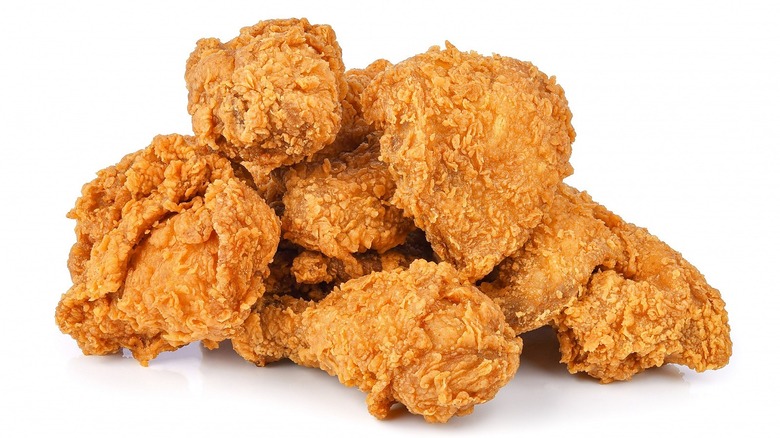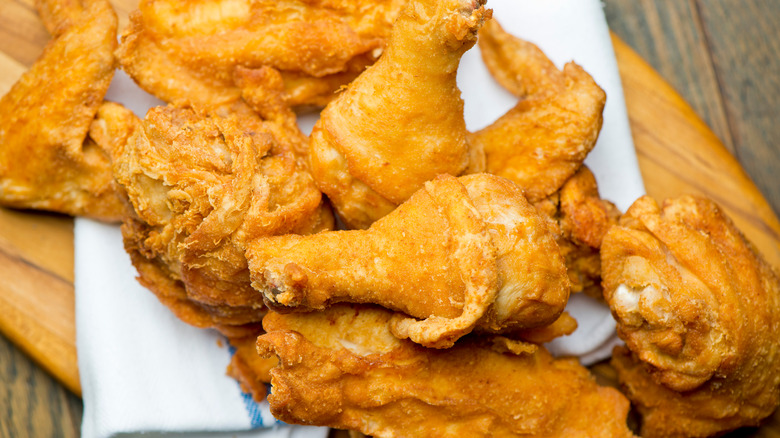The Unexpected Ingredient That Can Take Your Fried Chicken To The Next Level
There are few dishes more irresistible on a menu than fried chicken. This special occasion meal is more popular than ever as fast food chains and fancy restaurants alike compete for the top honor of "best." The weekend picnic staple is approaching its peak season, ready to be served on a plate surrounded by mashed potatoes and greens or sandwiched between pickles and coleslaw on a soft bun. As irresistible as fried chicken is to many meat-eaters, it can be equally daunting for home cooks to make.
While most recipes agree that chicken should be brined, dredged, then fried to achieve the best results, how we get there is up for debate with variations on the type of flour to use, ingredients in the brine, and which oil is best. Fear not, hungry readers; we've got a few tricks up our sleeve (including an unexpected ingredient) for the most delicious chicken breasts, thighs, and legs you've ever sunk your teeth into, just in time for National Fried Chicken Day on July 6 (mark your calendars).
Brine your chicken with this unexpected ingredient
The marinade or brine often called for in a fried chicken recipe is a salty liquid that you soak the uncooked chicken in for around two to 24 hours, depending on your method. The reason why brining is important is because it keeps the chicken from drying out when cooked. The liquid hydrates the muscle fibers in the meat via osmosis, and the mixture can be as simple as salt and water. But why stop there? According to Wonder How To Food Facts, adding alcohol to a fried chicken brine creates a crispier crust. Serious Eats explains that booze evaporates faster than water does, which helps limit gluten formation and dry the crust of the chicken to make it light and crispy, rather than thick and soggy. You can use vodka for a neutral taste, while bourbon is added for more flavor. Don't worry about the alcohol content since most of it will burn off in the cooking process.
Other ingredients can take your boozy brine to the next level. World-famous Nashville hot chicken has cayenne pepper and hot sauce in the brine to bring that heat. Another trend is pickle-brined fried chicken, which soaks the meat in pickle juice for 24 hours before transferring it to buttermilk. This results in flavorful, moist chicken that doesn't need as much seasoning later on in the cooking process, says Scrambled Chefs. After brining your chicken, here's how you can complete it to perfection.
Dredge it real good
Once your chicken is flavorful on the inside, it's time to coat or dredge the parts to form the crust. First, one of the many ways to screw up fried chicken is to not pat it dry with a paper towel before dredging, which prevents the crust from falling off later (and what a shame that would be). The coating can be made from any type or combination of flour seasoned with little else besides salt and pepper. James Beard Award-winning chef Sean Brock uses both all-purpose flour and cornmeal to add more texture to the crust, whereas Bon Appétit calls for a 50/50 mixture of AP flour and cornstarch to achieve a crunch you can hear.
While fried chicken batter should always be seasoned, the most flavor often comes from the brine and/or final condiments. Every culture has its version of fried chicken, BBC reports. The Japanese use a blend of soy sauce, garlic, and ginger in their marinade, while Guatemalan fried chicken is flavored with citrus and spices before taking a dip in the oil. And crispy fried chicken tossed in a thick, sweet, and salty chili paste called gochujang is known as Korean fried chicken.
Do this for golden-brown, crispy fried chicken
Now that you've seasoned the inside of the chicken with brine and the exterior with a flour mixture, it's time to fry. Ideally, cooks should use a cooking thermometer to regulate the temperature of the oil to maintain around 325 degrees Fahrenheit. A neutral-tasting vegetable oil will highlight the flavors of the chicken and has a high smoke point, while the combination of lard and butter preferred by chef Sean Brock imparts a smokier, heartier flavor. Whichever fat you choose, food editor Andy Baraghani advises cooks to remove the chicken from the pot once it's perfectly browned, then finish it off in a 400-degree oven until the internal temperature of the meat reaches 165 degrees.
If, instead, your chicken reaches 165 degrees but still has a pale crust, Wonder How To Food Facts suggests a double-fry. Remove the chicken and allow it to cool on the counter for up to half an hour. Before serving, reheat your oil and fry the chicken until it's golden — so the crust browns and the interior warms up without cooking more. Luckily in this time of high oil costs, cooks can reuse frying oil to save money. To finish off your chicken, season it again with salt and allow it to rest for 15 minutes to become the juiciest, crunchiest, most finger-licking chicken you've ever had.



